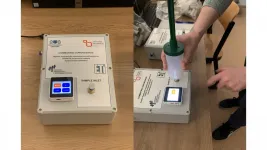(Press-News.org) WASHINGTON, July 6, 2021 -- Emitted as gases from certain solids or liquids, volatile organic compounds (VOCs) include a variety of chemicals. Many of these chemicals are associated with a range of adverse human health effects, from eye, nose, and throat irritation, to liver, kidney, and central nervous system damage.
The ability to detect VOCs in air samples simply, quickly, and reliably is valuable for several practical applications, from determining indoor air quality to screening patients for illnesses.
In Review of Scientific Instruments, by AIP Publishing, researchers at Gda?sk University of Technology, in Poland, describe a measurement device designed to analyze air samples containing various VOCs.
The setup "utilizes commercial and prototype resistive gas sensors of low-energy consumption to detect volatile organic compounds, such as methane, ethanol, toluene, methylene, nitrogen dioxide, formaldehyde, ammonia, among others, in air samples," said researcher Andrzej Kwiatkowski. "The sensors change their resistance in the presence of VOCs, which exist in the environment and exhaled breath."
After environmental conditions like humidity, temperature, and air pressure are monitored, the device inhales an air sample, either from the atmosphere or from a breath sample, enabling the sensors within its 220-milliliter aluminum gas chamber to analyze and respond to detection of VOCs in real situations.
Consisting of the gas chamber, a set of electrical valves, and an electrical micropump, the device is controlled by a touch-screen electronic module that can process and save data. Sensor responses are recorded and can be parametrized for further data processing using various detection algorithms.
In practical applications, the instrument can detect and measure the presence of VOCs within the span of 10 minutes.
"The setup is a low-cost device of simplified maintenance and service," said Janusz Smulko, one of the co-authors. "Additional environmental sensors boost the accuracy of gas sensing by correcting effects induced by temperature and humidity changes. The device can monitor the air quality collected in a human environment, such as in an office or warehouse, to detect molds or bacteria by emitted smells.
"In medical applications, doctors can investigate the exhaled breath of patients by this noninvasive method to signal the need for a more detailed checkup."
The researchers are currently applying it in hospital studies to determine the difference in the exhaled breath between healthy volunteers and patients infected by the COVID-19 virus.
INFORMATION:
The article "Embedded gas sensing set-up for air samples analysis" is authored by Andrzej Kwiatkowski, Katarzyna Drozdowska, and Janusz Marek Smulko. The article will appear in Review of Scientific Instruments on July 6, 2021 (DOI: 10.1063/5.0050445). After that date, it can be accessed at http://aip.scitation.org/doi/10.1063/5.0050445.
ABOUT THE JOURNAL
Review of Scientific Instruments publishes novel advancements in scientific instrumentation, apparatuses, techniques of experimental measurement, and related mathematical analysis. Its content includes publication on instruments covering all areas of science including physics, chemistry, materials science, and biology. See https://aip.scitation.org/journal/rsi.
Mammals have a poor ability to recover after a spinal cord injury which can result in paralysis. A main reason for this is the formation of a complex scar associated with chronic inflammation that produces a cellular microenvironment that blocks tissue repair. Now, a research team led by Leonor Saude, group leader at Instituto de Medicina Molecular Joao Lobo Antunes (iMM; Portugal) and Professor at Faculdade de Medicina da Universidade de Lisboa, have shown that the administration of drugs that target specific cellular components of this scar, improve functional recovery after injury. The results now published in the scientific journal Cell Reports* set the basis for a new promising therapeutic strategy not ...
From the bark of a puppy to the patter of rain against the window, our brains receive countless signals every second. Most of the time, we tune out inconsequential cues--the buzz of a fly, the soft rustle of leaves in the tree--and pay attention to important ones--the sound of a car horn, a bang on the door. This allows us to function, navigate and, indeed, survive in the world around us.
The brain's remarkable ability to sift through this ceaseless flow of information is enabled by an intricate neural network made up of billions of synapses, specialized junctions that regulate signal transmission between and ...
PITTSBURGH, July 6, 2021 - Scientists from the University of Pittsburgh School of Medicine described a new phenomenon in which the deletion of a single gene involved in liver embryogenesis completely wipes out bile ducts of newborn mice. But despite a major defect in their bile excretion system, those animals don't die immediately after birth. Rather, they survive for up to eight months and remain physically active, if small and yellow-tinted.
Published today in the journal Cell Reports, the finding offers clues as to why some patients with cholestasis--or impaired ...
What The Study Did: Rates at which patients with type 2 diabetes received diabetes-related health services prior to and during the COVID-19 pandemic are compared in this study.
Authors: Ateev Mehrotra, M.D., M.P.H., of Harvard Medical School in Boston, is the corresponding author.
To access the embargoed study: Visit our For The Media website at this link https://media.jamanetwork.com/
(doi:10.1001/jamainternmed.2021.3047)
Editor's Note: The article includes conflict of interest and funding/support disclosures. Please see the article for additional information, including other authors, ...
What The Study Did: COVID-19 vaccine-associated messenger RNA (mRNA) wasn't detected in 13 human milk samples collected after vaccination from seven breastfeeding mothers.
Authors: Stephanie L. Gaw, M.D., Ph.D., of the University of California, San Francisco, is the corresponding author.
To access the embargoed study: Visit our For The Media website at this link https://media.jamanetwork.com/
(doi:10.1001/jamapediatrics.2021.1929)
Editor's Note: The article includes conflict of interest and funding/support disclosures. Please see the article for additional information, including other authors, author contributions and affiliations, conflict ...
What The Study Did: This study in the Lombardy region of Italy examined the association of different health care professional categories and operational units, including in-hospital wards and outpatient facilities, with the seroprevalence of positive IgG antibody tests for SARS-CoV-2 and the likelihood of SARS-CoV-2 infection.
Authors: Piero Poletti, Ph.D., of the Bruno Kessler Foundation in Trento, Italy, and Marcello Tirani, M.D., Directorate General for Health, Lombardy region, in Milan, are the corresponding authors.
To access the embargoed study: Visit our For The Media website at this link https://media.jamanetwork.com/
(doi:10.1001/jamanetworkopen.2021.15699)
Editor's Note: The article includes ...
What The Study Did: This national analysis examined the association between the travel distance to the nearest abortion care facility and abortion rate and the effect of reduced travel distance.
Authors: Kirsten M. J. Thompson, M.P.H., of the University of California, San Francisco, is the corresponding author.
To access the embargoed study: Visit our For The Media website at this link https://media.jamanetwork.com/
(doi:10.1001/jamanetworkopen.2021.15530)
Editor's Note: The article includes conflict of interest and funding/support disclosures. Please see the article for additional ...
What The Study Did: The amount Medicare pays for common generic prescriptions in Part D was compared with prices available to patients without insurance at Costco.
Authors: Erin Trish, Ph.D., of the University of Southern California, Los Angeles, is the corresponding author.
To access the embargoed study: Visit our For The Media website at this link https://media.jamanetwork.com/
(doi:10.1001/jamainternmed.2021.3366)
Editor's Note: The article includes conflicts of interest disclosures. Please see the article for additional information, including other authors, author contributions and affiliations, conflict of interest and financial disclosures, and funding and support.
INFORMATION:
Media advisory: The full study is linked ...
Melbourne researchers have identified a way to improve the immune response in the face of severe viral infections.
It is widely known that severe viral infections and cancer cause impairments to the immune system, including to T cells, a process called immune 'exhaustion'. Overcoming immune exhaustion is a major goal for the development of new therapies for cancer or severe viral infections.
A team from the Peter Doherty Institute of Infection and Immunity (Doherty Institute) led by University of Melbourne's Dr Sarah Gabriel, Dr Daniel Utzschneider and Professor Axel Kallies has been able to identify why immune exhaustion occurs and how this may be overcome.
The team had previously identified that while some T cells ...
Most human cells are able to repair damage by dividing at wounds.
But mature nerve cells (neurons) in our brain are different. If they attempt division, they will likely die - and this is what happens during brain injury, or in conditions such as Alzheimer's Disease (AD). Now new research led by the University of Plymouth has uncovered a pathway that has shed new light on how these divisions may be triggered.
The research, published today in Cell Reports, has focused on intracellular structures called microtubules - which are found in most animal cells, and can be damaged by a build-up of a protein called Tau in the brain during AD.
The study was conducted in fruit flies, with comparison to postmortem brain samples ...



